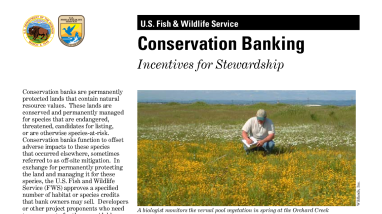Conservation banks are permanently protected lands that contain natural resource values. These lands are conserved and permanently managed for species that are endangered, threatened, candidates for listing, or are otherwise species-at-risk. Conservation banks function to offset adverse impacts to these species that occurred elsewhere, sometimes referred to as off-site mitigation. In exchange for permanently protecting the land and managing it for these species, the U.S. Fish and Wildlife Service approves a specified number of habitat or species credits that bank owners may sell. Developers or other project proponents who need to compensate for the unavoidable adverse impacts their projects have on species may purchase the credits from conservation bank owners to mitigate their impacts. This document provides answers to frequently asked questions regarding conservation banking.
Type of document
Fact Sheet
Program

